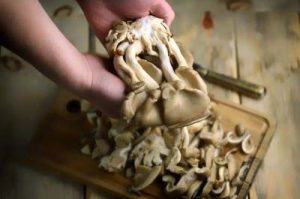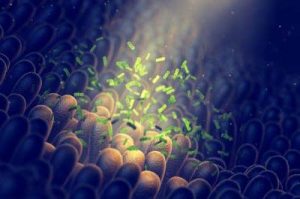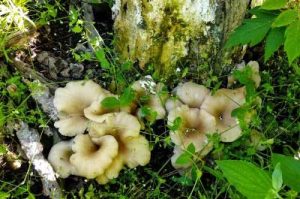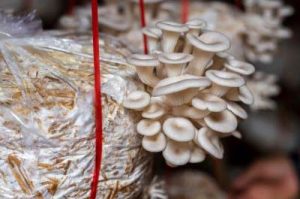
Every person is unique!
Our experienced team will be happy to advise you in detail and free of charge on all matters relating to your health. Book your consultation appointment now:
Pleurotus - The vital mushroom for a healthy intestine and healthy vessels
February 2, 2022
Dr. Dorothee Bös et al.
Pleurotus ostreatus is the vitamin bomb among the vital mushrooms. Also known as “oyster mushroom”, this mushroom is considered a nutritious as well as tasty meat substitute in cuisines around the globe. In addition to B vitamins, it contains many different health-promoting substances. That is why it is often used to improve metabolism and thus prevent diseases of civilization. Read here what other positive effects pleurotus can have on your health.
What is the pleurotus or oyster mushroom?
Pleurotus: A vital mushroom full of healthy substances
If you take a closer look at the ingredients of Pleurotus, it quickly becomes clear why it is considered a vital mushroom. For example, for a mushroom, it is very rich in various vitamins, iron and amino acids. It also has an extremely healthy ratio between the macronutrients fat, protein and carbohydrates. In addition, there are various minerals and medically active substances, which we will present to you in more detail in a moment. After that, you will definitely understand why this mushroom, of all things, is now used in modern cuisine as a “functional food”. With its valuable ingredients, even staple foods such as flour or yogurt are enriched to make them true health boosters.
Pleurotus - The vitamin bomb
Micro- and macronutrients in oyster mushrooms
 Compared to protein, oyster mushroom is rather low in fat, but still contains important unsaturated fatty acids. Carbohydrates are again abundant. Among them are various long-chain carbohydrates such as polysaccharides, which have a positive effect on the organism. Of particular note is beta glucan – a compound of polysaccharides and beta D-glucose. In research, it always surprises with various health-promoting properties. For example, it has antioxidant effects, hinders the spread of metastases and prevents Parkinson’s disease.
Compared to protein, oyster mushroom is rather low in fat, but still contains important unsaturated fatty acids. Carbohydrates are again abundant. Among them are various long-chain carbohydrates such as polysaccharides, which have a positive effect on the organism. Of particular note is beta glucan – a compound of polysaccharides and beta D-glucose. In research, it always surprises with various health-promoting properties. For example, it has antioxidant effects, hinders the spread of metastases and prevents Parkinson’s disease. Other health-promoting substances
Simply request free information brochures now!

After you have sent the completed form, you will receive an e-mail with a download link.
What is the effect of pleurotus?
For a long time, the vital mushroom Pleurotus ostreatus has been used in alternative medicine. Experience from traditional Chinese medicine (TCM) shows that it has an anti-inflammatory effect and has a particularly soothing effect on pain in the musculoskeletal system. In addition, the following effects of the ingredients have been studied:
- cholesterol lowering
- antimicrobial (antibiotic and anti-mycotic)
- antiviral
- immunomodulating
- antiallergic
- anti-cancer and -preventive
Improvement of the metabolism
 Even the fat deposits in the heart, aorta and muscles can be reduced with the help of the oyster mushroom. This is especially helpful for people who want to transition to a healthier lifestyle and lose weight. Because the fat in the muscle cells makes it enormously difficult to lose weight. It interferes with the cellular power plants (mitochondria) that are responsible for converting fat or sugar into usable energy.
Even the fat deposits in the heart, aorta and muscles can be reduced with the help of the oyster mushroom. This is especially helpful for people who want to transition to a healthier lifestyle and lose weight. Because the fat in the muscle cells makes it enormously difficult to lose weight. It interferes with the cellular power plants (mitochondria) that are responsible for converting fat or sugar into usable energy. Prevent high blood pressure and arteriosclerosis
Taking care of the gut with oyster mushrooms
 By taking vital mushroom powder, good intestinal bacteria such as lactobacilli, enterococci and bifidobacteria measurably increase. The immune system also benefits from this, as many cells important for the body’s defenses are formed in the intestines. It is therefore advisable to consume the oyster mushroom regularly as an adjunct to, or at the latest following, antibiotic therapy. Namely, while it supports the antibiotic effect, it simultaneously alleviates the damaging effect of the antibiotic on the intestinal flora.
A healthy intestinal environment is always accompanied by a strong nervous system. Good intestinal bacteria form short-chain fatty acids, which are enormously important for our nerves. People suffering from chronic inflammatory bowel disease may also benefit from taking Pleurotus. They are helped especially by the combination of prebiotic and anti-inflammatory effects. In both humans and animals, oyster mushroom has also proven to be a therapeutic remedy for diarrheal diseases.
By taking vital mushroom powder, good intestinal bacteria such as lactobacilli, enterococci and bifidobacteria measurably increase. The immune system also benefits from this, as many cells important for the body’s defenses are formed in the intestines. It is therefore advisable to consume the oyster mushroom regularly as an adjunct to, or at the latest following, antibiotic therapy. Namely, while it supports the antibiotic effect, it simultaneously alleviates the damaging effect of the antibiotic on the intestinal flora.
A healthy intestinal environment is always accompanied by a strong nervous system. Good intestinal bacteria form short-chain fatty acids, which are enormously important for our nerves. People suffering from chronic inflammatory bowel disease may also benefit from taking Pleurotus. They are helped especially by the combination of prebiotic and anti-inflammatory effects. In both humans and animals, oyster mushroom has also proven to be a therapeutic remedy for diarrheal diseases. Pleurotus against allergies
In addition to all the health-promoting properties already mentioned, scientists also attribute an anti-allergic effect to pleurotus. On the one hand, this is probably due to the beta-glucan pleuran, which has a balancing effect on the immune system. On the other hand, the vital mushroom reduces the release of histamine, which plays a supporting role in many allergic reactions. Ultimately, a healthy intestinal flora itself is a preventive factor against allergies. Therefore, at this point, the prebiotic properties of the oyster mushroom also come into play. In the alternative medicine field, the combination of Pleurotus, Reishi and Hericium has proven to be effective in relieving allergies and even atopic dermatitis.
Antioxidant and oncoprotective effects
Free radicals often play a major role in the development of tumors. That is why a high level of antioxidants in the body means at the same time a certain protection against cancer. Scientists have now been able to show that the oyster mushroom activates various antioxidant systems in the body: superoxide dismutase, catalase and glutathione. In animal studies, these enzymes/antioxidants were even shown to protect the organism when it was exposed to chemicals. In expert circles, there is therefore a presumption that the pleurotus can prevent chemically induced colon cancer.
Activation of the antioxidant glutathione system and consequent increase in the level of glutathione peroxidase in the liver represents a protective factor for this organ. A deficit of glutathione peroxidase can, for example, be due to the intake of certain painkillers and means a burden for the liver. By stimulating glutathione peroxidase, Pleurotus does something good for the liver. At the same time it relieves them through its positive regulation of cholesterol levels.
During chemotherapy and radiation treatment, oyster mushroom can be taken concomitantly to somewhat cushion the side effects on the bone marrow and support the intestinal immune system. Breast cancer patients showed significantly better levels regarding tumor-relevant immune cells under the administration of pleuran from Pleurotus. In animal studies, an anti-leukemic effect of the ingredients was shown. In vitro, the ingredients from the vital mushroom could even damage cancer cells, but it is not possible to transfer this mechanism 1:1 to the body, here it is different mechanisms of action.
A benefit for the musculoskeletal system
Defense against pathogens and parasites
 Besides its antibiotic effect, the vital mushroom inhibits the spread of candida in the body. So it is generally considered to be antimicrobial. We have already addressed its antiviral effects. Scientists believe that the ingredients of the oyster mushroom both act directly on the viruses and trigger various immune mechanisms. Its overall antiviral power has already been demonstrated in widespread viruses such as herpes simplex.
Besides its antibiotic effect, the vital mushroom inhibits the spread of candida in the body. So it is generally considered to be antimicrobial. We have already addressed its antiviral effects. Scientists believe that the ingredients of the oyster mushroom both act directly on the viruses and trigger various immune mechanisms. Its overall antiviral power has already been demonstrated in widespread viruses such as herpes simplex. Background info and tips for buying Pleurotus ostreatus
As you have now learned, taking the vital mushroom Pleurotus is useful for various health complaints and risks. However, it is not enough to prepare a delicious mushroom dish with oyster mushrooms every week. It is certainly healthy and tastes good, but for noticeable effects on health, a certain amount of the mushroom must be taken daily. Learn here how to recognize the vital mushroom, where to buy it and how best to take it. In case of ambiguities and further questions about individual dosage and combination with other medicinal mushrooms, please feel free to contact our experts.
How do I recognize oyster mushrooms in the wild?
 in tufted colonies. These protrude laterally from thick branches as well as tree trunks and may well grow several meters above the ground. A weakling parasite, Pleurotus also thrives well on stumps of dead trees. It can feed on conifers, but clearly prefers deciduous trees. In our latitudes, his absolute favorite tree is the copper beech.
The cap of the young oyster mushroom is usually smooth, has a whitish-bluish to slate-gray color and resembles the shape of a tongue. With age, the hat develops into a semicircle, the diameter of which can reach 25 centimeters. It also changes to a brownish color. The lamellae, spores and flesh always remain white. When you find an oyster mushroom, it is best to check the texture and smell of the flesh: while a young mushroom is soft and pleasantly fragrant, the flesh of the old mushroom is hard and musty.
The white stalk is usually less than four centimeters long, sometimes only rudimentary. There are other species of seitlings that look similar to Pleurotus, but are poisonous. Therefore, if you collect specimens yourself, you should always be absolutely sure that you are looking at the real oyster mushroom before eating it. In addition to its appearance, a distinctive feature of the edible mushroom is that it forms its fruiting body in late autumn or even in winter. Only when the thermometer drops below 5° for a certain time, the pleurotus begins to grow.
in tufted colonies. These protrude laterally from thick branches as well as tree trunks and may well grow several meters above the ground. A weakling parasite, Pleurotus also thrives well on stumps of dead trees. It can feed on conifers, but clearly prefers deciduous trees. In our latitudes, his absolute favorite tree is the copper beech.
The cap of the young oyster mushroom is usually smooth, has a whitish-bluish to slate-gray color and resembles the shape of a tongue. With age, the hat develops into a semicircle, the diameter of which can reach 25 centimeters. It also changes to a brownish color. The lamellae, spores and flesh always remain white. When you find an oyster mushroom, it is best to check the texture and smell of the flesh: while a young mushroom is soft and pleasantly fragrant, the flesh of the old mushroom is hard and musty.
The white stalk is usually less than four centimeters long, sometimes only rudimentary. There are other species of seitlings that look similar to Pleurotus, but are poisonous. Therefore, if you collect specimens yourself, you should always be absolutely sure that you are looking at the real oyster mushroom before eating it. In addition to its appearance, a distinctive feature of the edible mushroom is that it forms its fruiting body in late autumn or even in winter. Only when the thermometer drops below 5° for a certain time, the pleurotus begins to grow. Where does the oyster mushroom grow?
 In any case, it is important that no chemicals are used. These accumulate first in the fungus and later in the consumer. Vital mushrooms from a cultivation according to German organic guidelines are therefore safest. Since Pleurotus is both a useful vital mushroom and a nutritious and tasty edible mushroom, it enjoys great popularity among cooks. After the mushroom and shiitake, it is the third most cultivated in the world.
After harvesting, the mushroom ideally dries at temperatures below 40 ° Celsius. In this way, it is preserved for a long time and its valuable ingredients are retained. Since the health substances are distributed throughout the mushroom, then the whole mushroom should also be ground into powder. By filling the powder into capsules, an even longer shelf life can be achieved. Moreover, capsules are relatively easy to dose.
In any case, it is important that no chemicals are used. These accumulate first in the fungus and later in the consumer. Vital mushrooms from a cultivation according to German organic guidelines are therefore safest. Since Pleurotus is both a useful vital mushroom and a nutritious and tasty edible mushroom, it enjoys great popularity among cooks. After the mushroom and shiitake, it is the third most cultivated in the world.
After harvesting, the mushroom ideally dries at temperatures below 40 ° Celsius. In this way, it is preserved for a long time and its valuable ingredients are retained. Since the health substances are distributed throughout the mushroom, then the whole mushroom should also be ground into powder. By filling the powder into capsules, an even longer shelf life can be achieved. Moreover, capsules are relatively easy to dose. How do I take Pleurotus ostreatus?
We would like to note here that vital mushrooms have no side effects. Therefore, you cannot harm yourself by using the wrong dosage. If you initially consume a lot of mushroom powder, it can only affect their digestion, as the metabolism and especially the detoxification of the organism are stimulated. However, in order to meet your individual health constitution, exact dosage and perfect combination with other measures is indispensable. Therefore, be sure to consult with your naturopath, mycologist, or our experts before taking Pleurotus. This way you are on the safe side that the desired effects will actually occur over time.
For mushroom powders there are many suppliers
You will find trustworthy suppliers with controlled organic cultivation in Germany, but unfortunately also less recommendable importers of cheap goods. Read what is important when buying.
DO YOU HAVE ANY QUESTIONS?
We will gladly take time for you. In our free consultation we answer individually and personally all your health questions under:

Every person is unique!
Our experienced team will be happy to advise you in detail and free of charge on all matters relating to your health.
Scientific studies / sources
- Prof. Dr. med. Ivo Bianchi: “Modern Mycotherapy”; Hinckel Druck, 2008
- Stamets, P.: “MycoMedicinals: An Informational Treatise on Mushrooms,” Myco Media, 2002.
- Hobbs, C.: “Medicinal Mushrooms”, Botanica Press, 1995.
- Lelley, Prof. Dr. J.: “The healing power of mushrooms”, GAMU, Krefeld, 2003
- Komarkova E. et al: “Prebiotics from Pleurotus ostreatus and P. eryngii”; Int. Journal of Medicinal Mushrooms, Vol. 9, 2007.
